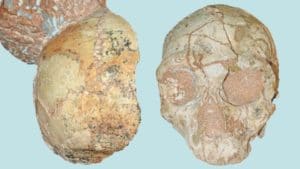The Story of Humans and Neanderthals in Europe Is Being Rewritten
Ed Yong, Atlantic, July 10, 2019
In 1978, in a cave called Apidima at the southern end of Greece, a group of anthropologists found a pair of human-like skulls. One had a face, but was badly distorted; the other was just the left half of a braincase. {snip}
{snip}
The one with the face, known as Apidima 2, is a 170,000-year-old Neanderthal — no surprises there. But the other, Apidima 1, was one of us — a 210,000-year-old modern human. And if the team is right about that, the partial skull is the oldest specimen of Homo sapiens outside Africa, handily beating the previous record holder, a jawbone from Israel’s Misliya Cave that’s about 180,000 years old. “I couldn’t believe it at first,” Harvati says, “but all the analyses we conducted gave the same result.”
Until now, most researchers have focused on the more complete (but less interesting) of the two skulls. “Apidima 1 has just been ignored,” says Harvati. But its antiquity matters for three reasons. First, it pushes back the known presence of modern humans outside Africa by some 30,000 years. Second, it’s considerably older than all other Homo sapiens fossils from Europe, all of which are 40,000 years old or younger. Third, it’s older than the Neanderthal skull next to it.

Apidima 1 (left) is a modern human; Apidima 2 (right) is a Neanderthal.
Collectively, these traits mess up the standard story of Neanderthal and modern-human evolution. According to that narrative, Neanderthals slowly evolved in Europe, largely isolated from other kinds of hominins. When modern humans expanded out of Africa, their movements into Europe might have been stalled by the presence of the already successful Neanderthals. That explains why Homo sapiens stuck to a more southerly route into Asia, and why they left no European fossils until about 40,000 years ago. “The idea of Europe as ‘fortress Neanderthal’ has been gaining ground,” says Rebecca Wragg Sykes, an archaeologist from the University of Bordeaux, but identifying a 210,000-year-old Homo sapiens skull from Europe “really undermines that.”
“It suggests that early Homo sapiens groups got farther than we may have previously thought, occasionally occupying territories that later became that of Neanderthals,” adds Shara Bailey, an anthropologist at NYU. {snip}
The identity of Apidima 1 could also cast doubt on other archaeological finds from Europe, such as stone tools with no accompanying fossils. Researchers had long assumed that within a certain time window, “any archaeology was all the work of Neanderthals,” says Wragg Sykes. But if modern humans also occupied this “safe range,” which species actually created those artifacts?
{snip}
How much information can scientists really glean from just the back of the skull, and just the left half at that? Actually, quite a lot, Harvati says: That region is very informative when telling different hominins apart. Apidima 1 lacks several traits that are distinctively Neanderthal, while its rounded shape “is considered to be a uniquely modern human feature that evolved relatively late,” Harvati says.
But “it doesn’t look like classic Homo sapiens,” says Wragg Sykes, who wonders whether it represents a group of humans that had been interbreeding with Neanderthals or other ancient hominins. “Obviously everyone is going to want to see DNA out of that skull,” she adds.
{snip}
The Apidima skulls also suggest that the accepted story of Europe, in which modern humans eventually replaced the long-dominant Neanderthals, is too simple. Instead, Harvati thinks that modern humans were already in Greece about 200,000 years ago; they were then replaced by Neanderthals, who were themselves replaced by humans about 40,000 years ago. A similar cycle of competition, where Neanderthals and humans repeatedly replaced each other, seems to have happened in the Levant, the Middle Eastern region that includes Israel and Syria. {snip}
{snip}
Greece is a good place to start. “It’s at the crossroads of three major continents, and it’s a refuge where animals and humans could survive at the height of the ice ages,” Harvati says. “You’d predict population dispersals and range contractions in these areas, the possibility for contact [between different groups], and a more diverse human-fossil record than you’d find in distant parts of Europe. There aren’t many fossils in the region, but it hasn’t been much of a research priority.”
{snip}















